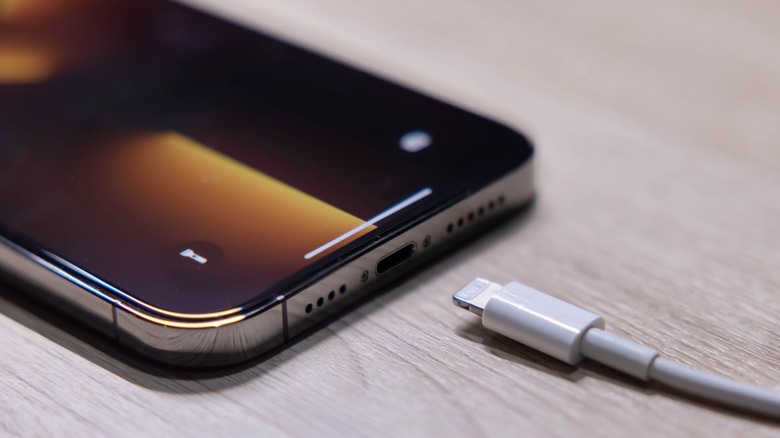How Apple's iPhone Is Affected By Europe's New USB-C Rule
The European Union is moving forward with a proposal that will make it mandatory for all new smartphones sold in the bloc to adopt the USB-C port. The legislation, which has been voted upon favorably by the European Parliament and the European Council, now needs to be formally approved before it can come into effect. The outlined rules cover both smartphones and tablets, alongside digital cameras, video game consoles, and audio wearables across a total of 15 product categories.
Aside from standardizing the USB-C port, the EU is also pushing for a single charging brick that can juice up all the aforementioned device classes, saving consumers from forking out cash on different chargers for each device. Moreover, buyers will need to be offered a choice between purchasing a device with the supplied charger, or without it, just in case they already have a charger at their disposal.
Going a step further, the regulation aims to solve the messy wireless charging situation, especially with the diversity of protocols out there. There's also a provision for standardizing the port situation on laptops, but manufacturers have 40 months after the initial legislation comes into effect — which could be as early as 2024 — to accommodate that. One possible outcome is that proprietary charging solutions for laptops such as Apple's MagSafe or Microsoft's Surface Connect port will either take a backseat in favor of USB-C charging, at least in the EU market, or simply go extinct for good.
Lightning strikes for the iPhone
Unsurprisingly, Apple stands to face the biggest headache from the EU's landmark legislation. The company has remained loyal to the cause of its Lightning port on iPhones, even though it has transitioned much of its iPad line-up to the USB-C standard over the past few years. However, Apple has repeatedly resisted attempts to ditch the Lightning port in favor of USB-C on the iPhones. The reluctance is not surprising, as Apple has built a whole ecosystem of accessories and sells both in-house and third-party items tailor-made for the Lightning interface.
The EU's move makes it abundantly clear, though, that if Apple wants to sell iPhones in the bloc, it needs to put a USB-C connector on the iPhones by the year 2024. Alex Agius Saliba, the European Parliament's Rapporteur, made it clear during a press briefing that the move doesn't target Apple and that it applies to all brands whose products fall under the amended Radio Equipment Directive's aegis.
All the same, it appears that the directive to put USB-C on an iPhone may not come as the bombshell for Apple that many might think. Per previous leaks, Apple has already been testing USB-C port for charging and file transfer on its future iPhones, with a transition potentially happening in 2023 or a year after that. Either way, the change appears inevitable, and it could mean a big upset ahead for both iPhone users and accessory-makers alike.

